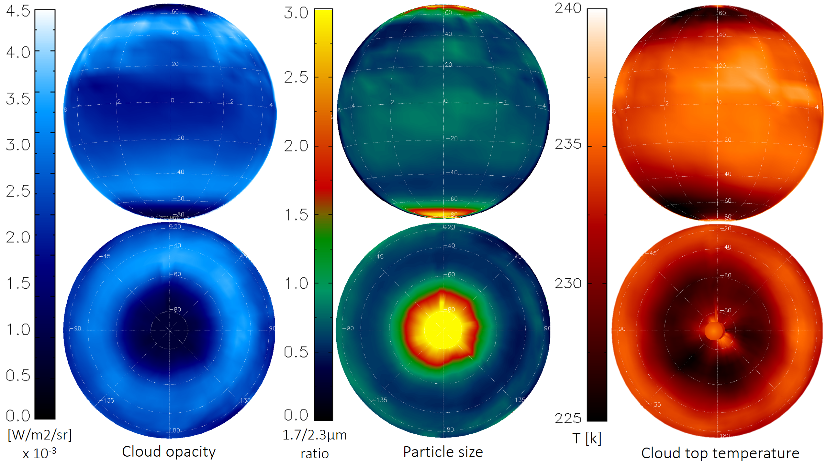Venus nightside atmosphere maps: cloud opacity, particle size and cloud top temperature seen by VIRTIS/Venus Express
- 1European Space Astronomy Centre, Spain (alejandro.cardesin@sciops.esa.int)
- 2Instituto de Astrofísica e Ciências do Espaço, Universidade de Lisboa, Obs. Astronomico de Lisboa, Portugal
- 3Istituto di Astrofisica e Planetologia Spaziali, Istituto Nazionale Astrofisica, Rome, Italy
- 4University of Maryland, College Park, MD, USA
- 5NASA Goddard Space Flight Center, Greenbelt, MD, USA
- 6European Space Research and Technology Center, Noordwijk, the Netherlands
- 7LESIA, Observatoire de Paris, Meudon, Paris, France
In this work we have produced global maps of Venus nightside atmosphere using the complete infrared dataset of VIRTIS mapping channel onboard Venus Express between 2006 and 2008. Despite the local variability and high dynamics of the clouds, the accumulation of data over several years allowed us to obtain a global mean state of the atmosphere, where we can observe the average structure of the clouds from equator to the polar regions with a high symmetry north/south even for the local time dependencies.
We have first obtained a global view of the nightside cloud opacity in the lower clouds mapping the integrated radiance in the infrared atmospheric windows around 1.74 μm and 2.3 μm (left maps in Figure 1). The radiance measured around these wavelengths originate below the cloud layer and both bands reflect the opacity of the lower cloud layer (44-48 km altitude), with common trends and high symmetry between the north and south hemispheres. Despite the common elements, the bands 1.74 and 2.3μm behave very differently with respect to the particle size, therefore the ratio between them provides an indirect estimation of the particle size distribution for these clouds, which is especially evident near the polar regions and also around the mid-latitude cloud belt (middle maps in Figure 1). We have then produced maps of the brightness temperatures in the thermal region around 3.8 μm and 5.0 μm, which provide a direct indication of the temperatures at the top of the clouds (60–70 km altitude) and the cooling with local time visible in both hemispheres (right maps in Figure 1).
Figure 1: Maps of Venus nightside atmosphere. Top maps represent latitude and local time (evening on the right, midnight in the center, morning on the left). Bottom maps are centered at the south pole and distributed with longitude. Left: Cloud opacity (inverse of the integrated radiance at 1.74μm, high opacity regions in both poles are dark due to the low radiance, mid-latitude clouds have highest radiance and lowest opacity). Middle: Particle size (ratio of the integrated radiance at 1.74 and 2.3μm, bright areas in both poles indicate larger particle sizes, mid-latitude cloud belt has smallest particle sizes). Right: Cloud top temperature (thermal brightness measured at 3.8μm, cold collar evening-morning cooling is visible and symmetric in both hemispheres).
These maps provide a global view of the global atmospheric dynamics at various altitudes, showing the main regions of the planet and the main characteristics in line with the latest general circulation models of Venus. The equatorial region shows a uniform cloud opacity and particle size, with no significant local time variations throughout the night except for the gradual temperature cooling of the cloud tops from evening to morning. The mid-latitude cloud belt extends uniformly over the night with the lowest opacity and lowest particle size distribution for both hemispheres, with an interesting asymmetry as the Northern hemisphere seems to have lower opacity and relative particle sizes. Towards the polar regions, the cold-collar appears with highest opacity and particle sizes, with a clear evening-to-morning cooling that had already been reported separately for the North and South hemispheres, and is now shown simultaneously providing a more global view of the atmospheric symmetry.
Reference publication: "Global maps of Venus nightside mean infrared thermal emissions obtained by VIRTIS on Venus Express". ICARUS, Volume 343, June 2020, 113683, https://doi.org/10.1016/j.icarus.2020.113683
How to cite: Cardesin-Moinelo, A., Piccioni, G., Migliorini, A., Grassi, D., Cottini, V., Titov, D., Politi, R., Nuccilli, F., and Drossart, P.: Venus nightside atmosphere maps: cloud opacity, particle size and cloud top temperature seen by VIRTIS/Venus Express, Europlanet Science Congress 2020, online, 21 September–9 Oct 2020, EPSC2020-142, https://doi.org/10.5194/epsc2020-142, 2020

